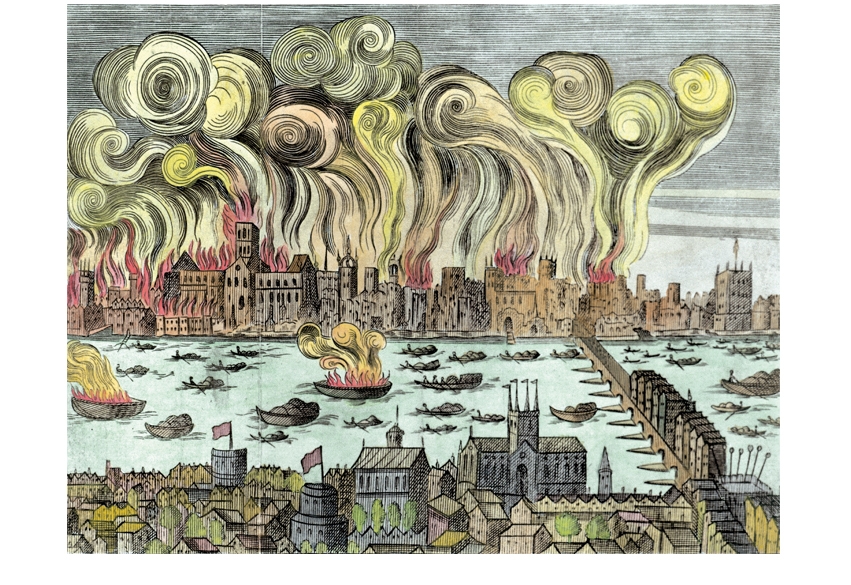Many among you, I know, have been fretting that thanks to a combination of political correctness, New Labour educational policy and the European Union’s usurpation of everything the free-born Englishman holds dear, big-picture narrative history is on the point of vanishing from the earth. All that our children’s children will know of British history, you worry, will be a vague sense of how beastly the Nazis were to Mary Seacole. Well, there is good news for you. Here are two new histories (of England, mind — not of Britain) by two of our best writers. Gosh, though. They could scarcely be more different.
Peter Ackroyd’s is very long — or promises to be. Foundation is only the first in a projected six-volume history running from the origins of Stonehenge (‘The Druids: no one knows who they were, or what they were doing’ —Spinal Tap. Ackroyd agrees) to the turn of the 21st century. That’s what historians, I believe, call a ‘demi-Gibbon’.
This first volume ends with the death of Henry VII in 1509, and the rejoicing of one noble that ‘avarice has fled the country’. ‘The days of royal avarice,’ Ackroyd corrects him with an audible rubbing of the hands, ‘were just beginning.’
His method is to shuttle back and forth between the top-line history of battles and kings, and the slower, more obliquely evidenced level of how life was lived. These are the chapters in which he really digs deep (his archaeological and philological work is exceptionally rich). They deal with the houses people lived in, the violence of their day-to-day lives; their forms of worship and trade; their crazy medicine; their understanding — as far as it can be divined — of the world about them.
Ackroyd isn’t a conventional historian, and never has been. He’s more engaged than that. He wants you to feel the loam of England, friable between the pads of finger and thumb. He wants you to taste — or, at least, smell — the food, and let your inner eye roam through the fields full of folk. He makes those folk strange yet familiar. Progress, he stresses, is the result of incremental accidents and conveniences. ‘No one was interested in creating a “state” ’ — yet that is what they did.
His deep theme is continuity — ‘the essential feature of England’. He shows us a system of shires that survived from the time of Athelstan to 1974; the Danish words that still nest in our language; the black eagle of Leofric still visible in Coventry’s coat of arms. He writes lyrically of how, from the air at dusk, the patterns of Bronze Age fields can still be seen on the contours of the English countryside.
At times, the mystic in him gets the upper hand. ‘Some unknowable bond exists between the economic and physical health of the nation,’ he writes, in the context of a rise in population during Henry III’s reign. Later, in Golden Bough mode, he says there’s ‘some strange alchemy between the state of the nation and the state of the monarch’, when three harvests on the trot failed during the reign of Edward II.
Every page throngs with chewy quotations, unexpected facts and conjectures, granular detail. His richly coloured prose — he has a showman’s forgivable weakness for the superlative — wraps it all up compellingly.
If Ackroyd’s book is an excavation, Simon Jenkins’s — which travels from the fifth century to the 21st in less than 400 pages — is an overflight: Sellar and Yeatman without the facetiousness, Our Island Story without the tweeness and the imperialism. This is traditional, kings-and-things, great-men history with all its dates and famous quotations in place. Chapters are called ‘Magna Carta’ or ‘Gladstone and Disraeli’.
Eleanors (Aquitane; Provence; Castile), surfeits (lampreys; peaches), parliaments (good, short, long), Henrys, poll tax riots, renaissances, reformations and counter-reformations shoot past. The ascendancy of the English longbow as a weapon of war lasts 20 pages. Peterloo gets two sentences.
It’s jolly good, though it’s hard to say exactly who it’s for. Too broad and too cursory to satisfy the history buff or serve as a serious reference, it’s perhaps aimed as a primer for teenagers not getting the big picture from the GCSE curriculum, and a ready reference for their parents.
Jenkins is whiggish in disposition, and the book’s golden thread is his interest in the evolution, in custom and common law, of the idea of government by consent. ‘The true English revolution was by the king against parliament, not, as popularly supposed, the other way round,’ he writes at one point. At another (of the Reform Bill passing into law): ‘1832, not 1688, was the true “glorious revolution”.’
As you’d expect, Jenkins has a newspaper columnist’s aphoristic verve and love of antithesis and inversion. ‘His father had fought to rule, but Henry VIII was a Plantagenet throwback, ruling to fight.’ The Restoration Parliament’s role was to ‘create a King, not be summoned by one’. The Dissolution of the Monasteries is drily described as ‘privatisation’.
Judgments are crisp. The Hundred Years War was a ‘chivalric feud’; the Wars of the Roses ‘senseless’; the American War of Independence ‘essentially an argument between loyalist and radical British subjects over trade and taxes’. Mrs Thatcher — with her centralising instinct and will-to-power — is rather splendidly described as ‘a ruler in Norman rather than Saxon style’.
The skill in covering such familiar material — particularly now you have Wikipedia as the competition — is to scatter nuggets of ‘coo’ and ‘gosh’ about the place: little details that stick in the mind. Did you know that the ‘Iron Duke’ was so named not for his resolve in battle but for the shutters he put over his windows in case rioters broke in? Or that Mary I was described by an ungallant Spaniard as ‘small and rather flabby’ with ‘no eyebrows’? Or that Charles II consulted the Royal Society for advice on the male erection? Or that in one 14th-century naval battle so much blood was spilt ‘it was said the fish spoke French’? Or that William Wallace made himself a belt out of the skin of a tax-collector? Well, I certainly didn’t, and I am glad I do now.
Reading the two alongside each other did raise some questions, though. Where do all these fun facts come from — and are they history or old wives’ tales? One hopes and trusts the former, but hope and trust is all one can really do.
Take the Lollards. Were they so named after the Dutch word for ‘mutterers’ (Jenkins) or a Dutch word meaning ‘to sing’ (Ackroyd). According to Jenkins, their leader John Wycliffe ‘produced the first translation of the Bible into English’; but Ackroyd writes that ‘it is not clear that one word of the supposed Wycliffe Bible was actually composed by Wycliffe himself’. Did their followers number ‘hundreds, rather than thousands, of adherents . . . in no sense a popular movement’ (Ackroyd)? Or, following Jenkins: ‘It was said of England in the 1390s that “every second man is a Lollard”.’?
My instinct is to think that Ackroyd, for whom this is the day-job and whose focus on the period is closer, will have things more nearly right. But since neither man footnotes a single source, your guess is as good as mine.







Comments